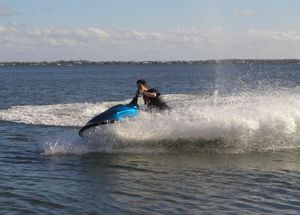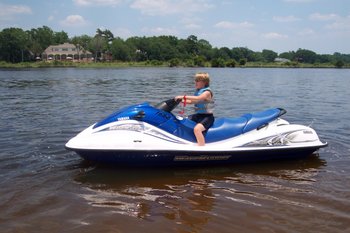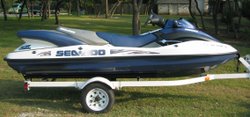Personal water craft

A personal water craft (PWC), or sea scooter, is a recreational watercraft that the rider sits or stands on, rather than inside of, as in a boat. Models have an inboard engine driving a pump jet that has a screw-shaped impeller to create thrust for propulsion and steering. They are often referred by the names WaveRunner, Jet Ski, or Sea-Doo, which are brand names owned by Yamaha, Kawasaki, and Bombardier, respectively.
Because of their relatively low cost and the freedom they afford to owners, PWC are widely used for recreation. However, many U.S. states require safety training for personal watercraft operators. Modern PWC include a lanyard attached to a dead man's switch, to turn off the vessel if the operator falls off -- provided the lanyard is attached to the operator.
Most are designed for two or three people, though four-passenger models exist. Stand-up PWCs were first to see mass production and are still popular for single riders. The invention of both major types of PWC is usually credited to Clayton Jacobsen II of Arizona, originally a motocross enthusiast.
Lake Havasu, Arizona, is a favorite for PWC riders and racers alike, and hosts the IJSBA World Finals for personal watercraft racing each October since 1982.
Some surfers use PWCs to get to the waves and get up to speed with them; this is known as tow-in surfing. They can also be used for towing water skiers on flat water.
Non-recreational uses
Although most PWCs are purchased by individuals for recreational use, they are also used for more serious purposes. PWCs are small, fast, easily handled, fairly easy to use, affordable and their propulsion systems, which do not have external propellers, are safer for swimmers and wildlife. For these reasons, they are sometimes used in preference to small motorboats.
Lifeguards in some areas use PWCs equipped with rescue platforms to rescue water users who get into difficulties and carry them back to shore. Rescuers have also used personal watercraft to pick up flood survivors.
PWCs have been used by biologists studying marine life.
PWCs are also used for law enforcement. Due to their high speed and excellent maneuverability, police and rangers use them to enforce laws on lakes and rivers.
A PWC combined with a wash-reduction system, carrying waterproof loudspeaker equipment and GPS for instructions and distance measurement, has purportedly been used by assistant coaches for rowing sports on the River Tyne.
Emissions

Before 1990, personal watercraft emissions were unregulated in the United States. Many were powered by two-stroke cycle engines, which are smaller and lighter than four-stroke cycle engines but much more polluting. Simple two-stroke engines are lubricated on a "total loss" method, mixing lubricating oil with their fuel; they are estimated to exhaust in excess of 25% of their fuel and oil unburned in addition to the products of incomplete and complete combustion.
The 1990 amendments to the Clean Air Act allowed the U.S. Environmental Protection Agency to begin regulating personal watercraft and other off-road internal combustion engines. The agency began a dialog with manufacturers in 1991, resulting in regulations that were enacted in 1996. These regulations, set to phase in between 1998 and 2006, are averaging standards, allowing manufacturers to offset more polluting engines in their range by selling other engines that exceed the standard. The U.S. state of California has adopted more stringent regulations than the federal standard.

To meet these regulations, manufacturers have adopted a variety of improvements, including increased use of four-stroke engines, the use of direct injection for two-strokes and the use of catalytic converters and other pollution-curbing measures that overall have reduced emissions by approximately 75% compared to pre-regulation models.
In some areas, only new personal watercraft that meet the current regulations are permitted; an example is Lake Tahoe.
Environmental groups such as the Surfrider Foundation and the Bluewater Network claim that more rapid progress could be made and the large numbers of older watercraft in use continue to emit substantial pollution.
Against this, industry groups such as the Personal Watercraft Industry Association point out that environmental groups continue to cite pollution levels of pre-regulation watercraft and ignore the improvements made to newer models; and furthermore, that personal watercraft are unfairly singled out when they are no more polluting than other powered boats.
List of popular brands
- Bombardier Recreational Products (Sea-Doo)
- Kawasaki (Jet-Ski)
- Yamaha (Waverunner)
- Honda (Aquatrax)
References
- U.S. Environmental Protection Agency. Gasoline Boats and Personal Watercraft.
- California Air Resources Board. Recreational Marine Engine Activities.
- Chad Nelsen (1988). Jet Skis Suck. Surfrider Foundation.
- Surfrider Foundation. (1988). Minimizing the Impacts of Personal Watercraft- Part II: Seeking a Solution.
- Personal Watercraft Industry Association. [1].
- Bombardier Recreational Products. About Sea-Doo.
- MIT Inventor of the Week Archive: Clayton Jacobsen II
